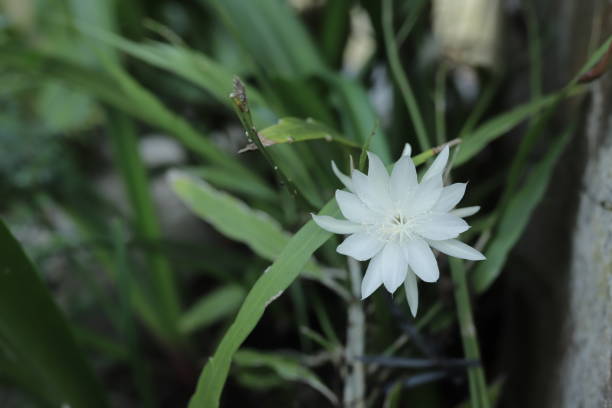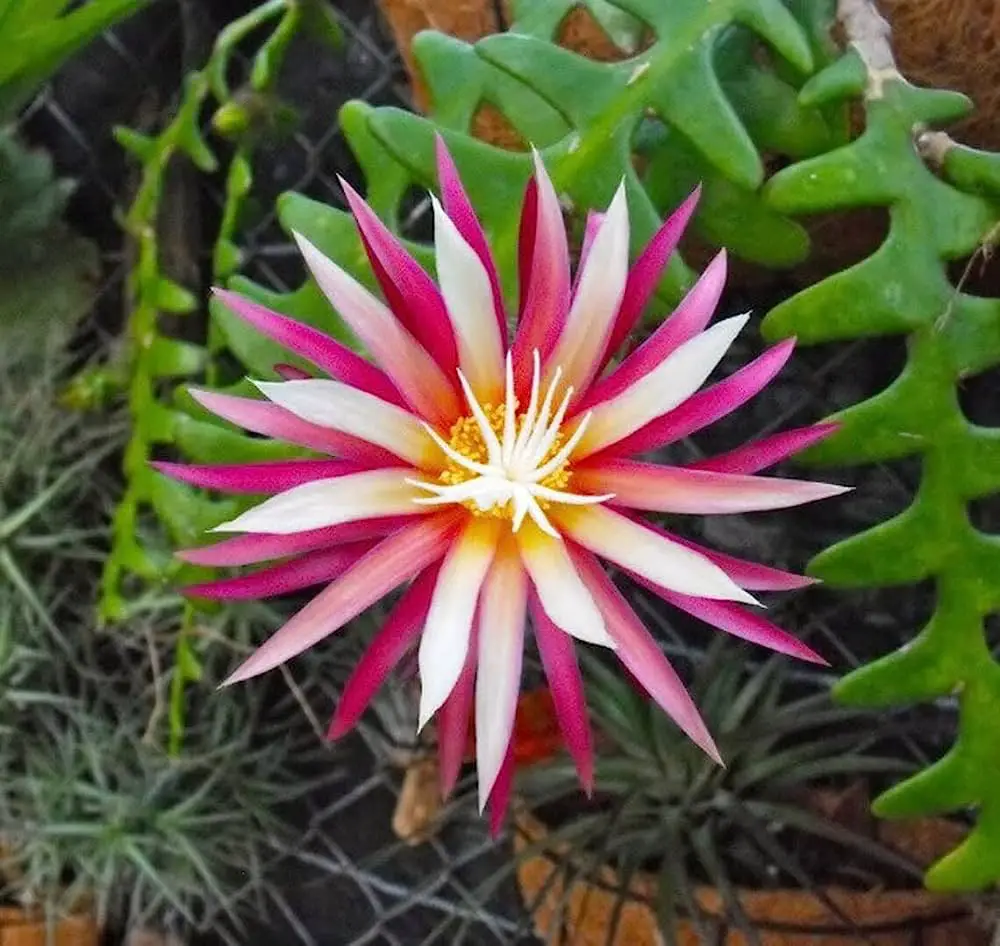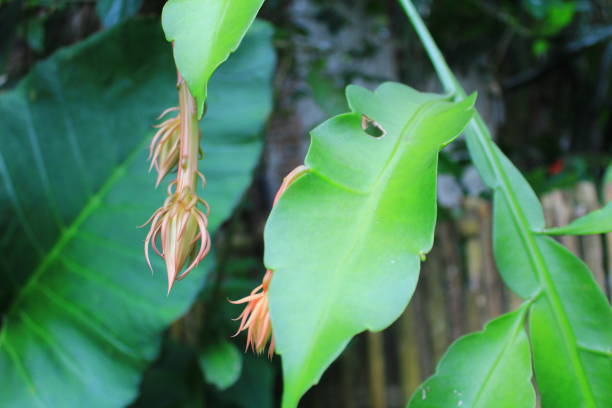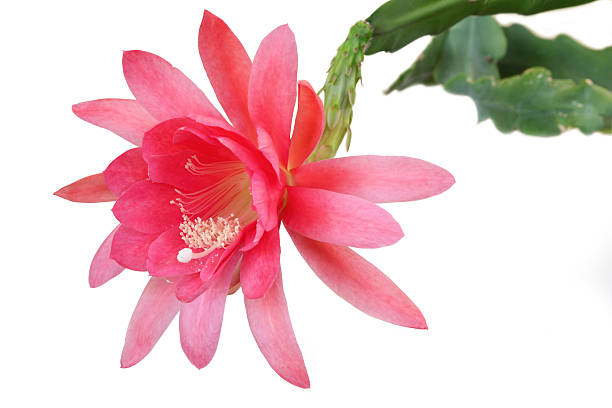Helpful Guides on each Category

Fishbone Cactus (Disocactus anguliger) is a type of cactus plant with flat, elongated segments that grow in a cascading fashion, resembling fishbones or delicate feathers.
The edges of the leaves are serrated, adding an extra touch of visual interest to this already captivating plant and homeowners really really love this plant.
One of the main reasons gardeners adore the Fishbone Cactus is its relatively low maintenance requirements. Unlike some finicky houseplants, this cactus thrives in conditions that are often found in typical indoor environments.
It tolerates a range of light levels, from bright indirect light to partial shade, making it suitable for various spaces within your home. Also, the Fishbone Cactus plant is forgiving when it comes to watering—too much or too little water won’t spell disaster for it.
Another reason the Fishbone Cactus has become a favourite is its ability to produce stunning blooms. Although the plant’s primary appeal lies in its foliage, it rewards its caretakers with elegant and fragrant blossoms when it does flower. The flowers typically appear at night, filling the air with a delightful scent and providing a magical experience for plant lovers.
Lets see how to care for and grow the Fishbone Cactus properly.
Fishbone Cactus (Disocactus anguliger) Plant Overview

The Fishbone Cactus (Disocactus anguliger), belongs to the family Cactaceae. This family includes various cactus species known for their unique adaptations to arid environments. Fishbone Cactus is a member of the epiphytic cactus group, meaning it grows on other plants or trees without deriving nutrients from them.
Native to the tropical rainforests of Central and South America, the Fishbone Cactus does better in Mexico, Costa Rica, and Brazil. In its natural habitat, it often grows as an epiphyte, clinging to trees or rocks while absorbing moisture and nutrients from the surrounding environment. These regions’ warm and humid climate provides the ideal conditions for its growth.
The Fishbone Cactus leaves are flattened stems, that grow in a pendulous manner, forming a zigzag pattern reminiscent of a fishbone or delicate feathers. These segments reach lengths of 6 inches (15 centimetres) and are dark green. The edges of the segments are serrated, further adding to the plant’s unique appearance.
| Scientific Name: | Disocactus anguliger |
| Common Names: | Fishbone Cactus, Zigzag Cactus, Ric Rac Cactus |
| Family: | Cactaceae |
| Growth Rate: | Moderate |
| Full Grown Size: | 6 feet (1.8 meters) in length |
| Bloom Time: | Spring, late summer |
| Sun Exposure: | Bright Indirect Light and Partial Shade |
| Soil Type: | Wet loamy, well-draining soil |
| Soil pH: | Acidic |
| Temperature: | 60°F to 75°F (15°C – 24°C) |
| Fertilizer: | balanced, water-soluble fertilizer diluted to half strength. |
| Toxicity: | A wet loamy, well-draining soil |
| Hardiness Zones: | 10a to 12b |
| Flower Colour: | White, Pink, Yellow |
Read Also: 51+ Best Plants for Fence Lines That Will Instantly Transform Your Boring Fence
Fishbone Cactus (Disocactus anguliger) Care

Lighting
Fishbone Cactus does not like direct sunlight as it does not like the full sun.
Provide it with bright indirect light, like a stage spotlight casting a gentle glow. Placing it near a north or east-facing window is ideal, where it can bask in the soft rays of the morning or evening sun. If your home lacks natural light, don’t fret! You can also use artificial grow lights to give your Fishbone Cactus the spotlight it deserves.
Temperature and humidity
It feels most comfortable in temperatures between 60 and 75 degrees Fahrenheit (15 to 24 degrees Celcius), so keep it away from chilly drafts and frosty windowsills.
As for humidity, it appreciates a moderate to high humidity level (about 65 per cent humidity), so consider misting its leaves occasionally or placing a tray of water near its pot to create a mini tropical oasis.
Soil
Use well-draining soil that allows excess water to escape. A mix of cactus or succulent potting soil and gritty additions like perlite or coarse sand is just what the fishbone cactus likes. This will keep the soil light and airy, preventing soggy roots and the dreaded encore of root rot.
To create the perfect potting mix for the Fishbone Cactus, blend equal parts of commercial cactus/succulent soil, perlite, peat moss, and orchid bark mix.
This well-drained and airy mixture, rich in organic matter, suits the epiphytic nature of the Fishbone Cactus perfectly.
Read Also: The 11 Best Wood for Raised Garden Beds. Budget, Durability & More.
Watering
Timing is everything when it comes to watering the Fishbone Cactus. It prefers a “sip, don’t gulp” approach.
Allow the soil to dry out slightly between waterings, and then give it a thorough watering until the water gracefully trickles out of the drainage holes. During the active growing season, water more frequently. However, as the cooler months roll in and the plant enters its dormancy period, reduce watering to give it a well-deserved rest.
Fishbone cacti are sensitive to chemicals commonly found in municipal water, especially if it’s hard water. To protect your cactus from potential harm, it’s best to either allow the water to sit out for 24 hours before watering or opt for distilled water. This ensures that any chlorine or minerals in the water have a chance to dissipate, providing a safer hydration option for your beloved fishbone cactus.
Fertilizer
To keep your fishbone cactus happy and healthy, a single dose of liquid cactus/succulent fertilizer in early spring will do the trick. Succulent fertilizer makes the cactus grow faster. As long as the potting medium contains organic matter such as peat moss or orchid bark mix, your fishbone cactus won’t require any additional fertilization throughout the year.
Feed it with a water-soluble fertilizer diluted to half strength every 2-4 weeks during the growing season. However, remember to hold off on the fertilizer during the winter months when the plant takes a break from its grand performances.
What are the types of fishbone cactus? Differentiating each
Disocactus anguliger, Epiphyllum anguliger, and Selenicereus anthocyanins are all commonly referred to as “fishbone cactus” due to their similar appearance and they do have a lot of similarities. However, they belong to different genera and have some distinct characteristics. Let’s differentiate between them:
Disocactus anguliger
- Commonly known as the “Fishbone Cactus” or “Ric Rac Cactus.”
- Belongs to the Disocactus genus.
- Features flat, zigzag-shaped stems that resemble a fishbone or a zigzag pattern.
- The stems are typically green and have deep, pronounced notches along their edges.
- Produces stunning, large, red or pink flowers that bloom at the ends of the stems.
- Requires partial shade and moderate watering.
- Native to Mexico.
Epiphyllum anguliger
- Also known as the “Fishbone Cactus” or “Moon Cactus.”
- Belongs to the Epiphyllum genus.
- Possesses long, flat, succulent stems that resemble a fishbone or a moon-shaped pattern.
- The stems have shallow, wavy notches along their edges.
- Produces fragrant, white flowers with a beautiful shape, blooming at night.
- Requires bright, indirect light and well-draining soil.
- Native to Central and South America.
Selenicereus anthonyanus
- Commonly referred to as the “Fishbone Cactus” or “Rickrack Cactus.”
- Belongs to the Selenicereus genus.
- Displays slim, succulent stems with prominent, deep, and wavy indentations, resembling fishbones or rickrack patterns.
- The stems are typically dark green and grow in a cascading or trailing manner.
- Produces lovely, nocturnal flowers that are red or magenta in colour.
- Requires bright, indirect light and moderate watering.
- Native to Mexico.
Propagating the Fishbone Cactus by Stem Cuttings

Stem cuttings are the best and most successful method for propagating fishbone cactus.
Do not during the fall and winter when the cactus enters its dormant phase. Instead, opt for spring and summer months to give your cuttings the best chance to thrive and grow into healthy plants.
Here is how to propagate your fishbone cactus by stem cutting
- Select a healthy, mature fishbone cactus stem with at least two or three segments.
- Using a clean, sharp knife or scissors, make a clean cut just below a segment, ensuring that the cutting is about 4-6 inches long.
- Allow the cutting to dry and callus over for a few days to prevent rotting.
- Prepare a well-draining potting mix by combining cactus/succulent soil with perlite or coarse sand.
- Insert the cut end of the stem cutting into the soil, burying it about an inch deep.
- Place the pot in a warm location with bright indirect light, avoiding direct sunlight.
- Water the cutting lightly, allowing the soil to dry out slightly between waterings.
- Be patient and resist the urge to disturb the cutting. It will take a few weeks to develop roots.
- Once the cutting has established a good root system, you can gradually increase the watering frequency and treat it as a mature fishbone cactus.
How to Propagate a Fishbone Cactus by Seed
This is the second-best way to grow a fishbone cactus plant. Here’s a step-by-step guide to propagating a Fishbone Cactus through the seed.
- Gather fresh fishbone cactus seeds from a mature plant or purchase them from a reputable source.
- Prepare a seed tray or small pots with a well-draining potting mix, such as a combination of cactus/succulent soil and perlite.
- Sow the seeds on the soil surface, gently pressing them down, but don’t bury them too deep.
- Mist the soil with water to ensure it’s moist but not soggy.
- Cover the tray or pots with a plastic dome or a clear plastic bag to create a mini greenhouse effect.
- Place the tray or pots in a warm location with bright indirect light.
- Check the moisture regularly and mist it if needed to maintain the desired level of humidity.
- Be patient! Germination can take several weeks or even months.
- Once the seedlings have grown a few sets of true leaves and are sturdy enough, you can transplant them into individual pots.
Pruning Fishbone Cactus plant
Although, the fishbone Cactus does not need frequent pruning to grow well, for the sake of beautification, trimming and grooming to shape is required. You can replant the cut branches.
Use clean, sharp pruning shears to carefully trim back any overgrown or unruly stems. Focus on removing excessive length or branches that disrupt the desired form.
If you notice any dead or damaged sections on your fishbone cactus, it’s time for a little intervention. Grab your pruning shears and gently snip away those unsightly parts.
Regularly cleaning and dusting its leaves not only keeps it looking fresh but also helps improve its ability to photosynthesize. Grab a soft, damp cloth or a gentle brush and gently wipe down each segment, taking care not to damage the delicate foliage.
For You: 39+ Best Hydroponic plants (Vegetables, Greens, Herbs and fruits) to grow Indoors hydroponically
Potting and Repotting

Opt for a pot with drainage holes. Go for a size that provides a snug fit for the plant’s root system, with a little room for growth. As for the potting mix, create a blend that’s both well-draining and nutrient-rich.
A mix of cactus/succulent soil, perlite, and a dash of organic matter like coco coir or orchid bark will give your fishbone cactus the solid foundation it deserves.
Follow these quick Step-by-step guides when potting a Fishbone Cactus:
- Select a pot with drainage holes that support heavy airflow and fill the bottom with a layer of small rocks or broken pottery shards to ensure proper drainage.
- Prepare your potting mix by combining cactus/succulent soil, perlite, and a touch of organic matter. Mix it well to achieve a uniform consistency.
- Gently remove the fishbone cactus from its current pot, taking care not to damage the delicate roots.
- Place the cactus into the new pot, making sure it’s centred and upright.
- Slowly fill the gaps around the roots with the prepared potting mix, gently pressing it down to provide stability.
- Leave a small space between the soil surface and the rim of the pot to allow for watering without overflow.
- Give your freshly potted fishbone cactus a good drink of water and let any excess water drain out.
- Find the perfect spot for your newly potted cactus, ensuring it receives the right amount of light and remains cosy in its new home.
How do I Know When to Repot my Fishbone Cactus plant?
As your fishbone cactus grows and thrives, it will eventually outgrow its current pot and demand a change of scenery. Repotting is like giving it a roomier stage to spread its roots and flourish. Generally, repotting every two to three years is sufficient.
However, keep an eye out for these signs that it’s time to repot:
- The roots are tightly packed and start to circle around the bottom of the pot.
- Water drains slowly or pools on the soil surface.
- The plant becomes top-heavy and has difficulty standing upright.
- The growth becomes stunted, despite proper care.
How to Make a Fishbone Cactus Plant Bloom

To encourage blooming in the fishbone cactus during late summer and fall, expose it to cool temperatures in winter to early spring (around 52-57 degrees Fahrenheit or 11-14 degrees Celsius). Resume regular care in late spring. Some growers have had success using high-potassium tomato fertilizer in summer to promote blooming later in the season.
If blooming doesn’t occur, don’t worry! Fishbone cacti can be challenging to bloom indoors and may require a few years of proper care before they are ready to flower. Patience and persistence will eventually pay off.
Is Fishbone Cactus Plant Toxic to Cats and Dogs?
The different plants identified as Fishbone Cactus (Disocactus anguliger, Epiphyllum anguliger, and Selenicereus anthocyanins) are non-toxic to cats and dogs. They are classified as a non-toxic plant by the American Society for the Prevention of Cruelty to Animals (ASPCA) and the Pet Poison Helpline.
Common pests and Plant diseases of Fishbone Cactus
Fishbone Cacti, like any other plant, can encounter common pests and diseases. While they are generally resilient, it’s important to be aware of potential issues that can affect their health. Mealybugs, Spider mites, and Scale insects are some common pests of fishbone cactus while Root rot and Stem rot (a fungal infection that affects the cactus’s stems) are diseases that affect fishbone cacti.
Regularly inspect your fishbone cactus for signs of pests or diseases, especially on the stems and foliage.
Common problems with fishbone cactus and their solutions
Fishbone cacti are generally low-maintenance plants, but they can experience common problems.
Here are some common problems and their respective solutions:
Wilting or drooping of the cactus
Cause
This can occur due to underwatering, overwatering, or insufficient light.
Solution
Adjust your watering routine by ensuring the soil is evenly moist but not waterlogged. Provide adequate indirect light for the cactus, avoiding direct sunlight. Find the right balance of water and light to revive the cactus and promote healthy growth.
Leggy growth
Cause
Insufficient light is typically the main cause of leggy growth in fishbone cacti.
Solution
Move the cactus to a brighter location with indirect sunlight. If natural light is limited, supplement it with artificial grow lights. This will encourage compact and sturdy growth, preventing the cactus from becoming leggy.
Wrinkled leaves
Cause
Wrinkled leaves usually indicate dehydration and underwatering.
Solution
Increase your watering frequency, ensuring that the soil is adequately moist but not waterlogged. Monitor the moisture levels closely and adjust the watering accordingly. Over time, the leaves should plump up and regain their turgidity.
Leaves and stems with brown spots
Cause
Brown spots can be a result of sunburn, fungal infections, or pests.
Solution
Provide the cactus with filtered or indirect sunlight to prevent sunburn. Inspect the affected areas for signs of pests or fungal infections. If pests are present, remove them manually or use an appropriate insecticidal soap. For fungal infections, treat with a suitable fungicide and ensure proper ventilation to reduce moisture levels.
Frequently Asked Questions
Fishbone cactus fruit is not edible. While the fruits develop on the cactus under suitable conditions, they are typically small and contain limited flesh.
Generally, fishbone cacti are slow to moderate growers compared to some other types of cacti.
From the young plant or cutting, it takes 1 to 2 weeks for the fishbone cactus to form roots, and after 2 months to begin noticeable growth.
The fishbone cactus is commonly considered an indoor plant. It is well-suited for indoor cultivation due to its adaptability to a wide range of indoor environments and its ability to thrive in relatively low light conditions.
They are sensitive to frost and cold temperatures, making them unsuitable for outdoor cultivation in cooler climates. As a result, they are predominantly grown as indoor plants or in greenhouse settings.
High temperatures, especially combined with excessive sunlight, cause fishbone cacti to turn red. The plant is just trying to protect itself from heat stress by producing pigments that provide some shade and help regulate temperature.
In some cases, a nutrient deficiency, particularly phosphorus or potassium, causes red discolouration in fishbone cacti.





